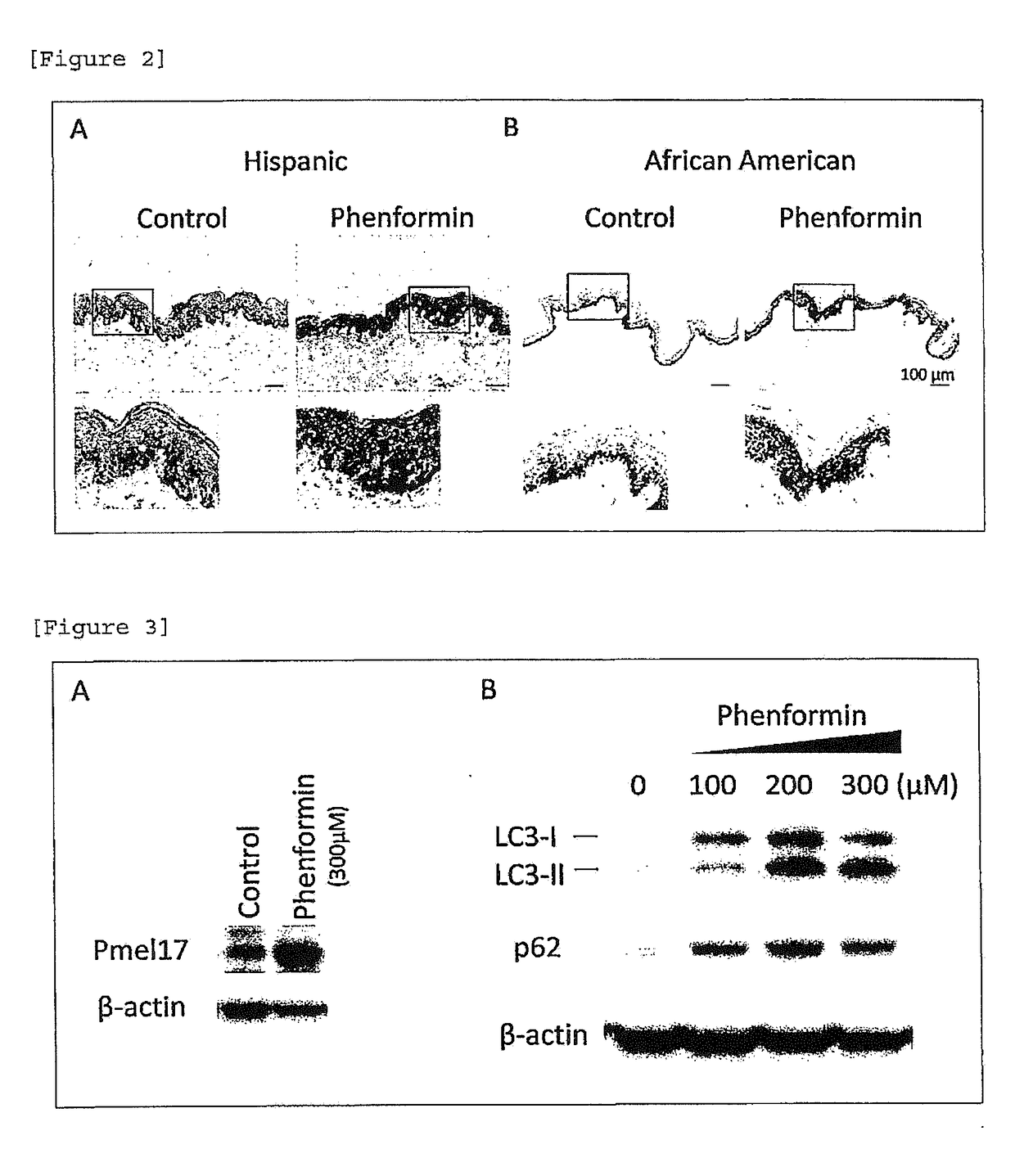Melanin Decomposition Inhibitor
a technology of melanin and inhibitors, which is applied in the direction of hair cosmetics, plant/algae/fungi/lichens ingredients, organic active ingredients, etc., can solve the problems of skin cancer, significant damage to the skin, and harm, and achieve the effect of darkening the skin color
- Summary
- Abstract
- Description
- Claims
- Application Information
AI Technical Summary
Benefits of technology
Problems solved by technology
Method used
Image
Examples
example 1
Skin Darkening Action in Human Skin Tissue
[0127](1) A normal human skin tissue obtained at the time of a surgical operation was purchased from a Skin Bank of the United States, National Disease Research Interchange (NDRI). The human skin tissue, from which subcutaneous fat was previously removed, was cut into pieces having a size of about 1 cm×about 1 cm by knife and cultured by using a 6-well plate at 37° C. under a 5% CO2 atmosphere. Advanced-DMEM medium containing 10% (v / v) Fetal Bovine Serum (FBS) (Life Technologies, respectively) was used for culture.
[0128](2) The human skin tissue prepared in accordance with the method described in the above (1) was allowed to stand still in the 6-well plate. Then, phenformin was added in the medium so as to have a final concentration of 300 μM and tissue culture was initiated. The medium replacement was performed every 2 to 3 days. Six days or eight days later, the appearance of the skin tissue was observed and photographed.
[0129]Skin tissues...
example 2
Melanin Accumulation Acceleration Action in Human Skin Tissue
[0132]The skin tissue derived from an African American and prepared in accordance with the method of Example 1 (1) was allowed to stand still in a 6-well plate and cultured in the presence or absence of phenformin for 6 days. Protein was extracted from the skin tissue and used for quantitative analysis of Pmel17 protein, which is a major protein constituting a melanosome, by Western-blotting. Using a mouse anti-human Pmel17 antibody (DAKO) as a primary antibody and a goat anti-mouse IgG antibody as a secondary antibody, signals were detected by using ECL prime reagent (GE Healthcare) and ODYSSEY Fc Imaging System (LICOR). Beta-actin protein as an internal standard was detected in the same manner. It was observed that the amount of Pmel17 protein is increased by phenformin, which is in conformity with induction of melanin deposition (FIG. 3A).
example 3
Inhibitory Action on Autophagy in Human Skin Tissue
[0133]Further, the skin tissue derived from an African American and prepared in accordance with the method of Example 1 (1) was allowed to stand still in a 6-well plate and cultured in the absence or presence of phenformin at a different concentration for 4 days. Proteins were extracted from the skin tissues and subjected to Western-blotting analysis. In this manner, the expression levels of LC3-II and p62 proteins, which are localized in autophagosome membrane and finally decomposed by autophagy, were determined. A mouse anti-human LC3 antibody (Cosmo Bio) and rabbit anti-human p62 antibody (MBL International) were used as primary antibodies. Since accumulation on both markers was observed by addition of phenformin, inhibition autophagy was suggested (FIG. 3B).
PUM
| Property | Measurement | Unit |
|---|---|---|
| time | aaaaa | aaaaa |
| temperature | aaaaa | aaaaa |
| size | aaaaa | aaaaa |
Abstract
Description
Claims
Application Information
 Login to View More
Login to View More - R&D
- Intellectual Property
- Life Sciences
- Materials
- Tech Scout
- Unparalleled Data Quality
- Higher Quality Content
- 60% Fewer Hallucinations
Browse by: Latest US Patents, China's latest patents, Technical Efficacy Thesaurus, Application Domain, Technology Topic, Popular Technical Reports.
© 2025 PatSnap. All rights reserved.Legal|Privacy policy|Modern Slavery Act Transparency Statement|Sitemap|About US| Contact US: help@patsnap.com



